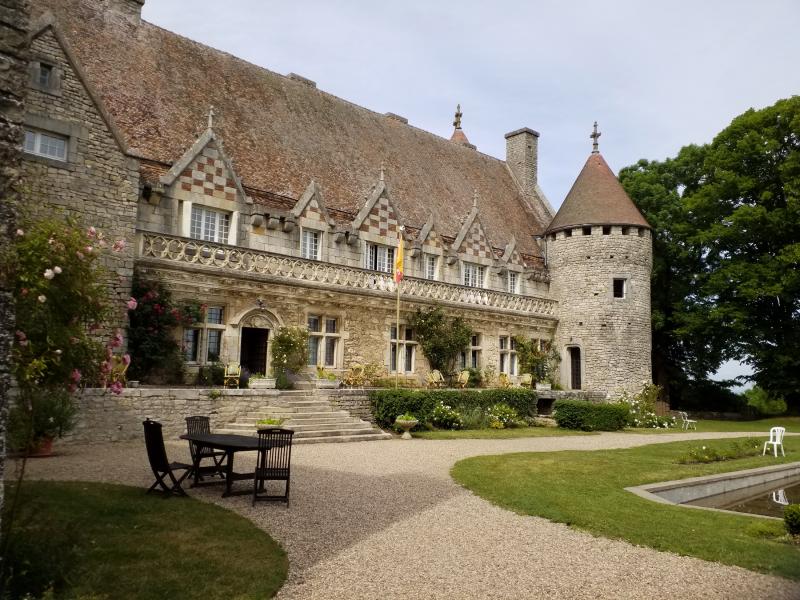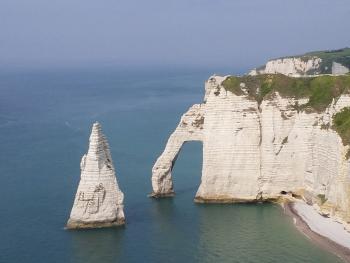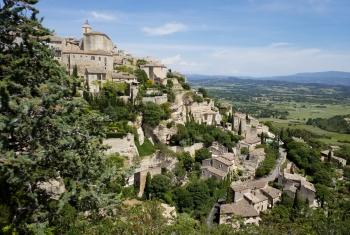A self-drive journey along the picturesque back roads of France
This article appears on page 32 of the June 2018 issue.
From May 22 to June 8, 2017, I had the opportunity to check off the No. 1 destination on my bucket list with a fantastic driving trip around France. However, to pull off this trip, I had two requirements: someone who could drive a stick-shift car and a fellow traveler who was fluent in French.
This all came together when my friend and former pastor, Cheryl Wessel, mentioned that she had been reading WWII literature, wanted to visit France and could drive a stick. My cousin Richard (Dick) Schroeder is always eager to go almost anywhere, and a former colleague of his, Steve Loomis, who taught French for 30 years, wanted to go along. My husband’s not liking road trips would save us some money.
Making plans
I gave my travel companions a preliminary price of about $3,000 each for our planned 17-day trip, but the total cost for everything came in at just under $2,000 per person by the time the arrangements were finalized.
When I first looked at airfares (Detroit-Marseille and Paris-Detroit), the cost was $1,500 for the round trip, so we ended up driving the 300 miles to Toronto to take advantage of an airfare of $540 per person for the same routing on Air Transat. It cost us about $35 each to drive to and leave the car parked in Toronto.
We rented a Hyundai Tucson for transportation in France for $555 from Europcar, booked through Auto Europe. The cost included CDW with no deductible and a GPS system. It was perfect for us, and the diesel engine saved us about 80¢ a gallon for the 2,600 miles that we drove.
I booked all accommodations over the Internet, mostly through Booking.com or directly, using recommendations from Rick Steves’ France guidebook. About half the places required cash payment at the time of our stay.
On the road
Setting out from Marseille, we stopped at the village of Gordes (one of the locations featured in the movie “A Good Year”) for a stroll and a lunch of baguettes and quiche.
At the village of Les Baux, we visited a very different “museum,” the Quarries of Light (€12, or $14), where old movies and artwork, accompanied by music, are projected on the walls of the quarry.
Our first chambre d’hôte was La Villages (13 rue de la Chapelle) in Vallabrègues. A double room in this 500-year-old modernized building cost €60, including an ample breakfast.
Steve said that his greatest joy of the trip was staying in this type of lodging, which he had never done before on any of his 30 trips to France. His fluent French enabled him to converse with our hosts, which he really enjoyed.
Our GPS came in handy for finding the off-the-beaten-path places in which we stayed.
After a stop at the Pont du Gard, a picturesque Roman aqueduct, the next day was spent mostly driving, passing spectacular scenery, through the Gorges du Tarn to Millau.
After overnighting in Millau, we took the autoroute over the Millau Viaduct to the walled city of Carcassonne, stopping at the quaint village of Minerve along the way. Our lodging in Carcassonne was Aude Cité-City (18 rue Fédou; www.audecitecity.com), about a 10-minute walk from the walled city. A double room cost €60, and free bikes were available, which we used in the morning to ride along the Canal du Midi.
On our way to the Dordogne, we stopped in the town of Saint-Cirq Lapopie. There were many tourists there, but we enjoyed our strolls and the views and had a picnic lunch using leftovers from breakfast.
We then ran into our first minor glitch. For our two nights in the Dordogne, we thought we had a reservation at Lys de Castelnaud (phone +33 [0] 5 53 28 2027, chambres-dordogne.com), but our hostess didn’t have our reservation, and the lodging was full. (She admitted that she had forgotten to send me a reply saying that I needed to send a deposit.)
She did find us a nice place nearby, which surprised me, since it was a 5-day holiday weekend (Ascension). There was a room for Cheryl and me for the second night, which pleased me, since the property was so medieval and quaint.
We hadn’t planned to go to the town of Sarlat, but it was very close, so we went there for dinner. I had a tasty meal of fois gras, duck breast in mushroom sauce, dessert and wine for €20 at Les Chevaliers de la Tour (15 rue Albéric Cahuet).
Village visits
The next day we followed a Rick Steves “Most Beautiful Villages” circle tour, beginning with the pilgrimage town of Rocamadour. I loved this town because it had free parking near the funicular that took us down to the church level, where there was an elevator to the main street. Its pilgrimage church is famous for the Black Virgin that sits above the altar in the chapel.
The other towns listed on this suggested route were lovely and not full of tourists.
Autoire has a waterfall, which we tried, unsuccessfully, to view from the top. However, we did find a nice spot by a stream that led to the falls where we ate our lunch of brie and crackers, fresh strawberries and walnut cake. (We later found out that the main view of the falls is from a trail at the bottom, at the edge of town.)
After driving through Loubressac, we stopped for a walk and drink at a Spanish café in Carennac. We were amused by a sign at the café that said “No duck here,” since most restaurants in this area feature duck in many forms.
After a short stop at the bastide town of Domme and dinner in La Roque-Gageac, my favorite village in the Dordogne, our journey continued with a mostly driving day to Tours.
Along the way, we made a special stop at the memorial village of Oradour-sur-Glane, a town with a tragic history. On June 10, 1944, the Nazis killed everyone in the town (642 people, including more than 200 children). The men were shot in small groups around the village, and the children and women were herded into the church, where many were shot before the church doors were locked and the church was set on fire.
The entire village was burned, and it has been left as it was found, with charred cars and stone walls supporting no roofs awaiting visitors.
Cheryl led us in a memorial worship in a side chapel of the ruined church, presenting a short homily that related the scriptures for the day to the village tragedy and the senseless carnage in our world today.
From farm to sea
Our next two nights were spent on a farm outside Tours so we could visit Château de Chambord and the gardens of Château de Villandry. Steve had lived in Tours for two years while overseeing a college exchange program, so he enjoyed seeing the changes. Villandry was a little disappointing because it was between spring and summer and mostly just the roses were in bloom.
In Ardevon, we spent two nights at Vent de Greves (7 Chemin des Dits), with a view of Mont Saint-Michel. It was modern and pleasant, at a cost of €56 (double) with breakfast.
We arrived at Mont Saint-Michel in time for lunch at Restaurant Saint Michel after passing up La Mère Poulard’s 34-euro omelets on the advice of Rick Steves. My lunch cost €17 for mussels, lamb in tomato sauce and dessert.
We explored the Mont with the crowds of other visitors. We would have preferred to be there in the evening, but our chosen restaurant was not open then during the off-season.
The next day was our day in Brittany, starting off with a stop in Dinan. This town was not crowded, and we roamed its picturesque streets.
We encountered crowds again in Saint-Malo, but it was time well spent. Cheryl walked the wall, and the three of us took the tourist tram and sampled traditional Breton kouign amann pastries. It is amazing that this city was so beautifully rebuilt after being destroyed in WWII.
Following the coast, we continued on our self-drive journey, heading to Les Rochers Sculptés, where carvings made by a hermit monk in the rocks along the shore can be found. Walking among them is not easy, but for the agile, it’s a special treat. That was followed by a short drive to Cancale for raw oysters (E6) and a seafood dinner at Chez Victor (8 quai de l’Administrateur).
Next on our itinerary were visits to Utah Beach and its museum and nearby Sainte-Mère, where a parachute hanging from the steeple commemorates an actual D-Day event.
The town was filled with people (many reenactors) gathering for June 6th observances.
Visiting Omaha Beach and the US cemetery there is always a moving experience. As a large tour group gathered (the first Americans we encountered on this trip), our national anthem was played on the chimes and a soldier played “Taps.”
Our lodging while in the Normandy region was Sebire Farm (emmanuelle.sebire@wanadoo.fr), recommended in the Rick Steves’ guidebook. This was our bargain accommodation of the trip, at €42 per room, but you need to like cats to enjoy your stay there.
Giverny to Paris
We had enjoyed almost perfect weather up to this point in the trip (the first few days were hot in the afternoon), but we had rain on our drive to Monet’s garden at Giverny. It stopped upon our arrival. The gardens were overflowing with blossoms.
It rained again on our drive to Versailles, but it stopped for our visit. Dick paid €25 for the tour so he could see the Hall of Mirrors and avoid the long security line. Cheryl and I chose to stroll through the gardens (€9.50 each), enjoying the music and fountains there.
We then headed east to Verdun, where we toured the Citadel Tunnels on a tram ride. The Douaumont Ossuary, which houses the bones of 130,000 French and German soldiers, located outside town, was well worth the visit.
Our lodging that night, Château de Hattonchâtel, was a special treat. It was my surprise for our group. Double rooms there cost €102, including a lavish breakfast with bacon and eggs. Dinner, however, would have cost €75 each, so we picked up pizza in town and enjoyed our exquisite surroundings.
We hated to leave, but we had to move on, traveling through Luxembourg to Bastogne in Belgium to tour a few more memorial sites before heading to Paris, where we planned to do a Discover Walks (discoverwalks.com) tour and have dinner on Île Saint-Louis. Our plan was thwarted by the man who attacked a policeman with a hammer outside Notre Dame on June 6. The hundreds of people waiting to get into the cathedral were herded inside, where they had to wait for about two hours.
We were on the street alongside the cathedral and were directed by police to go across the bridge to Île Saint-Louis, so we went ahead and had dinner there.
The whole area around the church was cordoned off, and the Métro and RER were closed in the area, so we had to walk to the next station to get the train back to the airport, where we caught a free shuttle to our Ibis hotel.
This was an unfortunate event in an otherwise perfect trip.
I can be reached at bpfaffen@aol.com for more info or comments.



